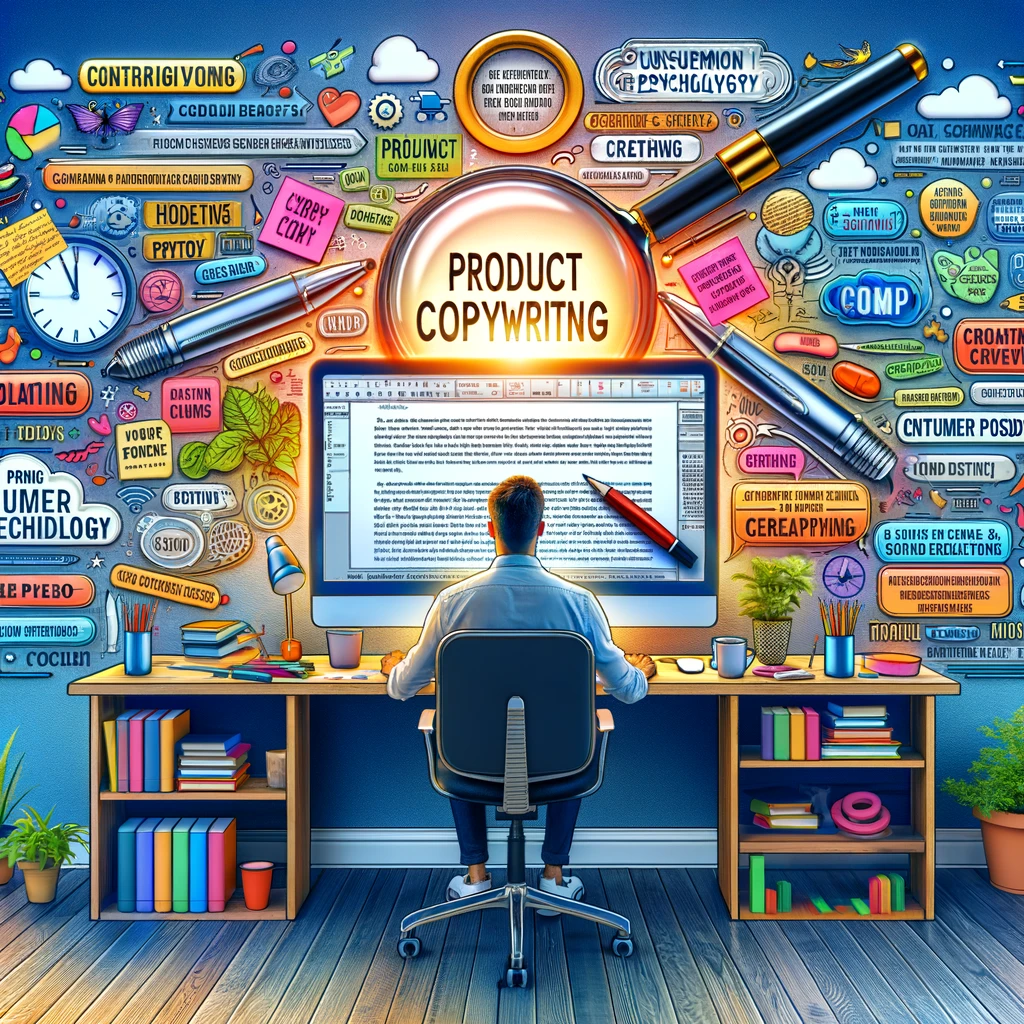
What is Product copywriting? – The art of creating persuasive product descriptions in written content. The marketing copy that showcases your products or services.
Introduction to Product Copywriting
Welcome to our beginner-friendly guide to product copywriting! If you’ve ever been curious about how to effectively promote your products and drive sales, you’ve come to the right place.
In this blog we will cover:
- What is Product Copywriting?: Delve into the definition of product copywriting, explaining its role in marketing and selling products online.
- Importance for E-Commerce Success: Highlight the significance of compelling product copy in attracting customers and persuading them to make a purchase.
- How it Helps Present Products: Discuss how product copywriting enables businesses to effectively communicate the features, benefits, and value proposition of their products to potential customers.
Exploring the Benefits:
- Driving Sales: Well-crafted product copy can influence buying decisions and ultimately boost sales for e-commerce businesses.
- Brand Perception: Building a positive brand image and fostering customer loyalty.
- Online Visibility: SEO keywords in product copywriting can improve search engine rankings and attract more organic traffic to product pages.
Effects of Product Copywriting:

- What does Product Copywriting do?: Product copywriting involves creating written content, such as product descriptions, headlines, and promotional materials, with the aim of persuading customers to make a purchase.
- Role in Marketing: Product copywriting serves as a crucial component of marketing strategies, helping businesses effectively communicate the unique selling points of their products to their target audience.
- Influence on Customer Perception: Effective product copywriting can shape the way customers perceive a brand and its products, influencing their buying decisions and overall satisfaction with their purchase experience.
Importance of Product Copy:
- Capturing Attention: Compelling product copy is essential for grabbing the attention of potential customers and drawing them into exploring product pages further.
- Persuading Customers: Well-crafted product descriptions and promotional content can persuade customers to take action and make a purchase by highlighting the benefits and value of the product.
- Building Trust: Engaging and informative product copy builds trust and credibility with customers, reassuring them about the quality and reliability of the products being offered.
Role in E-Commerce:
- Driving Conversions: Effective product copywriting plays a pivotal role in driving conversions and generating sales for e-commerce businesses by influencing customer purchasing decisions.
- Enhancing User Experience: Clear and informative product descriptions contribute to a positive user experience, helping customers make informed buying decisions and reducing the likelihood of returns or dissatisfaction.
- Differentiation and Branding: Product copywriting allows businesses to differentiate themselves from competitors and establish a unique brand identity by effectively communicating the distinctive features and benefits of their products.
Elements of Effective Product Copy:

Effective product copy requires attention to detail and a deep understanding of what resonates with your audience.
Clear Product Descriptions:
- Importance of Clarity: Clear and concise product descriptions are crucial for helping customers understand the features, benefits, and specifications of a product.
- Highlighting Key Features: Clearly outline the key features and functionalities of the product, providing customers with all the information they need to make an informed purchasing decision.
- Addressing Customer Needs: Tailor product descriptions to address the specific needs and pain points of your target audience, demonstrating how the product can solve their problems or fulfil their desires.
Headlines:
- Grabbing Attention: Attention-grabbing headlines are essential for capturing the interest of potential customers and encouraging them to explore product pages further.
- Communicating Benefits: Use headlines to succinctly communicate the main benefits or unique selling points of the product, enticing customers to learn more.
- Creating Curiosity: Intriguing headlines that spark curiosity or pose a question can pique the interest of customers and motivate them to engage with the product content.
Persuasive Language:
- Engaging Customers: Persuasive language, storytelling, and social proof are powerful tools for engaging customers and persuading them to make a purchase.
- Building Emotional Connection: Use emotive language and storytelling techniques to evoke emotion and create a connection with customers, helping them envision how the product can improve their lives.
- Leveraging Social Proof: Incorporate testimonials, reviews, and endorsements from satisfied customers to provide social proof and build trust with potential buyers, reassuring them about the quality and value of the product.
Effective product copy encompasses clear and concise descriptions, attention-grabbing headlines, and persuasive language that engages customers and motivates them to take action.
The Process of Product Copywriting:

Good product copy requires careful planning and execution. Three key stages of the process: research, writing, and editing and proofreading, and understand their importance.
Research:
- Understanding the Target Audience: Conducting thorough research helps in gaining insights into the demographics, interests, and preferences of the target audience. This knowledge enables you to tailor the product copy to resonate with their needs and desires.
- SEO Keywords: Identify relevant keywords and phrases that potential customers are likely to search for when looking for products similar to yours. Use tools like Google Keyword Planner to discover popular search terms and incorporate them naturally into your product descriptions.
- Analysing Product Benefits: Researching the product’s features and benefits is essential for effectively communicating its value to potential customers. Highlighting key benefits helps in showcasing how the product can solve their problems or improve their lives.
- Unique Selling Proposition (USP): Identify the unique features or benefits of the product that set it apart from competitors. Emphasise these USPs in your product copy to attract the attention of potential buyers and differentiate your product in the market.
- Assessing Competitors: Analysing competitor product descriptions provides valuable insights into market trends, customer expectations, and gaps in the market. This research helps in identifying opportunities to position your product effectively and create compelling copy that stands out from the competition.
- Unique Value Proposition (UVP): Determine what makes your product unique compared to competitors and emphasise these points in your product copy. Highlighting your product’s unique value proposition helps in persuading customers to choose your product over alternatives.
Writing:
- Writing Product Copy: Once you have gathered sufficient research, it’s time to start crafting the product copy. This involves structuring the content, selecting the appropriate tone and language, and incorporating SEO keywords to improve search engine visibility.
- Structure: Organise the product copy in a logical manner, with clear headings and bullet points to highlight key features and benefits.
- Tone and Language: Choose a tone and language that resonates with your target audience and reflects your brand’s personality. Whether it’s friendly, professional, or informal, ensure consistency throughout the copy.
- SEO Keywords Integration: Integrate relevant keywords naturally into the product descriptions to improve search engine rankings and attract organic traffic. Avoid keyword stuffing and focus on providing valuable information that meets the needs of potential customers.
Editing and Proofreading:
- General Accuracy: Editing and proofreading are crucial steps in the product copywriting process to ensure accuracy, clarity, and consistency. Thoroughly review the copy to correct any grammatical errors, factual inaccuracies, or inconsistencies.
- Product Accuracy: Verify product specifications, pricing information, and other details to ensure accuracy and credibility. Misleading or incorrect information can damage trust with customers and negatively impact sales.
- Clarity: Ensure that the product copy is easy to understand and free from confusing language or jargon. Use clear and concise language to convey information effectively and engage potential customers.
- Consistency: Maintain consistency in tone, style, and formatting throughout the product copy to create a cohesive and professional presentation. Inconsistencies can undermine the credibility of your brand and detract from the overall user experience.
Tips for Writing Effective Product Copy:

This requires a deep understanding of your audience and a focus on highlighting the benefits of your products in simple, accessible language. Some key tips to help you create product descriptions include;
Know Your Audience:
Understanding your target audience is crucial for creating product copy that speaks directly to their needs and desires.
- Demographic Research: Conduct thorough research to identify the demographics, interests, and buying behaviours of your target audience.
- SEO Keywords: Incorporate relevant keywords and phrases that resonate with your target audience’s search queries, helping to improve search engine visibility.
- Customer Personas: Develop detailed customer personas to gain insights into the motivations, pain points, and preferences of different segments of your target audience.
- Unique Selling Proposition (USP): Tailor your product copy to highlight the unique features and benefits of your products that are most relevant to your target audience.
Focus on Benefits:
Highlighting the benefits and value proposition of your products is key to persuading customers to make a purchase.
- Customer-Centric Approach: Frame your product descriptions in terms of the benefits they offer to customers, addressing their needs and desires.
- SEO Keywords Integration: Incorporate relevant keywords naturally into the product copy, focusing on long-tail keywords that capture specific benefits or solutions.
- Problem-Solution Format: Identify the problems or challenges your customers face and highlight how your products can solve them effectively.
- Testimonials and Reviews: Include testimonials and reviews from satisfied customers to provide social proof and reinforce the benefits of your products.
Keep it Simple:
Using simple, jargon-free language ensures that your product copy is easily understandable and accessible to a wide audience.
- Plain Language: Avoid technical terminology and industry jargon that may confuse or alienate customers.
- Clarity and Conciseness: Keep product descriptions clear, concise, and to the point, focusing on conveying the most important information.
- Accessibility: Make your product copy accessible to all customers, including those with limited English proficiency or cognitive disabilities.
- Readability: Use short sentences, bullet points, and headings to break up the text and improve readability, making it easier for customers to scan and understand the content.
Understand your customers’ needs, highlight the benefits of your products, and communicate in clear, jargon-free language.
SEO and Product Copywriting:

Optimising product copy for search engines is essential for improving online visibility and attracting organic traffic. What’s the importance of SEO in product copywriting and the steps involved?
Importance of SEO:
Use of SEO keywords into product copy helps search engine visibility and drives organic traffic to your product pages.
- Increased Visibility: By optimising product copy for relevant keywords, you can improve your website’s ranking in search engine results pages (SERPs), making it more likely for potential customers to discover your products.
- Targeted Traffic: Appearing in search results for relevant keywords ensures that your product pages are seen by users actively seeking products or information related to your offerings.
- Competitive Advantage: Effective SEO strategies give your business a competitive edge by helping you outrank competitors and attract more qualified leads to your website.
- Long-Term Benefits: Investing in SEO-optimised product copywriting can yield long-term benefits, as high-quality content continues to attract organic traffic over time.
Keyword Research:
Keyword research is a critical step in identifying relevant terms and phrases to incorporate into your product copy.
- Identify Target Keywords: Use keyword research tools such as Google Keyword Planner or SEMrush to identify high-volume, low-competition keywords relevant to your products.
- Long-Tail Keywords: Target long-tail keywords that capture specific product attributes, benefits, or use cases, as they often have lower competition and higher conversion rates.
- Analyse Competitor Keywords: Analyse competitor product pages to identify keywords they are targeting and discover additional keyword opportunities for your own product copy.
- User Intent: Consider the intent behind each keyword and prioritise those that align with the search intent of your target audience, whether it’s informational, navigational, or transactional.
Meta Tags:
Optimising meta titles and descriptions with relevant keywords is crucial for improving click-through rates and maximising visibility in search engine results.
- Meta Titles: Meta titles that accurately describe the content of your product page and include primary keywords at the beginning to optimise for search engines.
- Meta Descriptions: Write concise and engaging meta descriptions that provide a summary of your product and entice users to click through to your website. Incorporate secondary keywords naturally to improve relevance and visibility.
- Call to Action (CTA): Include a clear call to action in your meta description to encourage users to click through to your product page, such as “Shop Now” or “Learn More.”
- Testing and Optimisation: Continuously monitor the performance of your meta tags and experiment with different variations to identify the most effective combinations for improving click-through rates and driving traffic.
Conducting thorough keyword research and optimising meta tags with relevant keywords, businesses can maximise their visibility in search engine results and drive more qualified traffic to their product pages.
Examples of Effective Product Copy:
Studying examples of well-crafted product copy from leading e-commerce brands provides valuable insights into effective copywriting techniques that capture attention, engage customers, and drive conversions. Let’s explore some exemplary product descriptions and analyse the key elements that make them successful.
Example 1: Apple AirPods

Product Description:
“Introducing the Apple AirPods – the perfect blend of style, innovation, and performance. With effortless setup, seamless connectivity, and crystal-clear sound quality, AirPods deliver an unparalleled wireless listening experience. Designed to fit comfortably in your ears and stay in place during any activity, AirPods are the ultimate companion for your on-the-go lifestyle. And with Siri integration, you can control your music, answer calls, and more with just a voice command. Elevate your audio experience with Apple AirPods today.”
Key Elements:
- Persuasive Language: The description uses persuasive language to emphasise the product’s innovative features and benefits, such as “effortless setup,” “seamless connectivity,” and “crystal-clear sound quality,” enticing customers with the promise of a superior listening experience.
- Storytelling: The description tells a story of convenience and versatility, highlighting how AirPods seamlessly integrate into the customer’s lifestyle, whether they’re on the move or multitasking. This storytelling technique creates an emotional connection with the audience, making them envision themselves enjoying the product’s benefits.
- Social Proof: While the example does not explicitly include customer testimonials, the mention of Siri integration serves as a form of social proof, leveraging Apple’s reputation for innovation and user satisfaction to reassure potential buyers about the product’s quality and functionality.
Example 2: Nike Air Max Sneakers
Product Description:
“Elevate your style and performance with the Nike Air Max Sneakers. Featuring a lightweight design, responsive cushioning, and iconic Air Max technology, these sneakers deliver maximum comfort and support with every step. Whether you’re hitting the gym, running errands, or exploring the city streets, the Nike Air Max Sneakers provide unparalleled comfort and style. With a range of vibrant colours and sleek designs to choose from, there’s a pair to suit every taste and lifestyle. Step up your footwear game with Nike Air Max Sneakers today.”
Key Elements:
- Benefits-Oriented Language: The description focuses on highlighting the benefits of the product, such as “maximum comfort and support,” “responsive cushioning,” and “unparalleled style,” rather than just listing features. This approach appeals to customers’ desires for comfort, performance, and aesthetics, making the product more appealing and compelling.
- Visual Imagery: The description paints a vivid picture of the product experience, using descriptive language to evoke imagery of wearing the sneakers while engaging in various activities like “hitting the gym,” “running errands,” or “exploring the city streets.” This visual imagery helps customers imagine themselves wearing the product and experiencing its benefits first hand, increasing their desire to make a purchase.
- Limited Editions and Exclusivity: The mention of a “range of vibrant colours and sleek designs” suggests exclusivity and variety, appealing to customers who value individuality and self-expression in their footwear choices. This strategy taps into the psychological principle of scarcity, creating a sense of urgency and desirability around the product.
Effective product copy from leading e-commerce brands utilises persuasive language, storytelling, and social proof to capture attention, engage customers, and drive conversions.
Conclusion:

Product copywriting is essential for effectively showcasing your products and persuading customers to make a purchase. Key takeaways are;
Writing content that captures the attention of your audience and motivates them to take action.
- Understanding the Principles: Principles of product copywriting, including audience, benefits, and using persuasive language.
- Techniques: Storytelling, social proof, and SEO optimisation.
- Driving Sales and Success: Product copywriting has the power to drive sales, elevate brand perception, and position your business for success.
- SEO: Use SEO keywords into your product copy and meta tags, to improve search engine visibility and attract more organic traffic to your website.
- Descriptions: Highlight the unique features and benefits of your products to persuade customers to make a purchase.
- Your Brand: Investing in quality copywriting and embracing storytelling techniques, you can elevate your brand’s image and establish a strong emotional connection with your audience, fostering loyalty and repeat business.
Product copywriting is a powerful tool for driving sales and success in the world of e-commerce. Storytelling and persuasion will help you to see meaningful results in your business. So, embrace the art of product copywriting, and watch as your sales soar!




